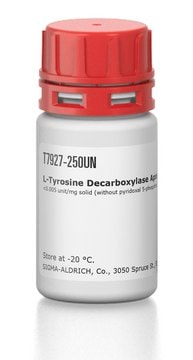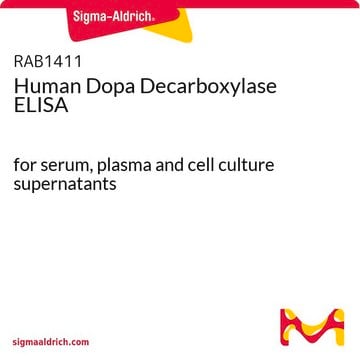T7677
L-Tyrosine Decarboxylase from Streptococcus faecalis
≥0.1 unit/mg solid
Synonym(s):
L-Tyrosine carboxy-lyase
Sign Into View Organizational & Contract Pricing
All Photos(1)
About This Item
Recommended Products
form
powder
specific activity
≥0.1 unit/mg solid
storage temp.
−20°C
Looking for similar products? Visit Product Comparison Guide
Application
L-Tyrosine decarboxylase from Streptococcus faecalis has been used in a study to isolate and identify the carbonyl-active site of diamine oxidase by gas chromatographic mass spectrometry. L-Tyrosine decarboxylase from Streptococcus faecalis has also been used in a study to investigate the adsorption of Streptococcus faecalis on diatomite carriers for use in biotransformations.
Other Notes
Dried cells from which activity can be extracted.
Unit Definition
One unit will cause the decomposition of 1.0 μmole of L-tyrosine per min at pH 6.2 at 37 °C.
Storage Class Code
11 - Combustible Solids
WGK
WGK 3
Flash Point(F)
Not applicable
Flash Point(C)
Not applicable
Personal Protective Equipment
dust mask type N95 (US), Eyeshields, Gloves
Certificates of Analysis (COA)
Search for Certificates of Analysis (COA) by entering the products Lot/Batch Number. Lot and Batch Numbers can be found on a product’s label following the words ‘Lot’ or ‘Batch’.
Already Own This Product?
Find documentation for the products that you have recently purchased in the Document Library.
F Buffoni
Analytical biochemistry, 220(1), 185-191 (1994-07-01)
An adduct with phenylhydrazine was formed with the purified pig kidney diamine oxidase and in parallel with the l-tyrosine decarboxylase from Streptococcus faecalis. The labeled enzymes were hydrolyzed by chemical hydrolysis and the adducts released by hydrolysis were isolated and
Characterization of bacterial L-(-)-tyrosine decarboxylase by isoelectric focusing and gel chromatography
Allenmark, C. and B. Servenius
Journal of Chromatography A, 153, 238-245 (1978)
W A Anderson et al.
Journal of chemical technology and biotechnology (Oxford, Oxfordshire : 1986), 47(2), 93-100 (1990-01-01)
Adsorption of cells on particulate carriers is potentially one of the most cost-effective immobilization techniques available. Diatomite carriers, such as Celite, have desirable physical properties, are inexpensive, and are suitable for both mycelial and bacterial systems. This work investigated the
Estefanía Muñoz-Atienza et al.
International journal of food microbiology, 146(2), 212-216 (2011-03-18)
In this work, biogenic amine production (histamine, tyramine and putrescine) by a collection of 74 lactic acid bacteria of aquatic origin has been investigated by means of amino acid decarboxylation by growth on decarboxylase differential medium, biogenic amine detection by
Vittorio Capozzi et al.
Food microbiology, 28(3), 434-439 (2011-03-02)
Enterococcus faecium strains were isolated from red wines undergoing malolactic fermentation and identified by comparison of their 16S rDNA gene sequences with those included in the GenEMBL Databases. The tyrosine decarboxylase gene was identified in all the strains analysed by
Our team of scientists has experience in all areas of research including Life Science, Material Science, Chemical Synthesis, Chromatography, Analytical and many others.
Contact Technical Service








